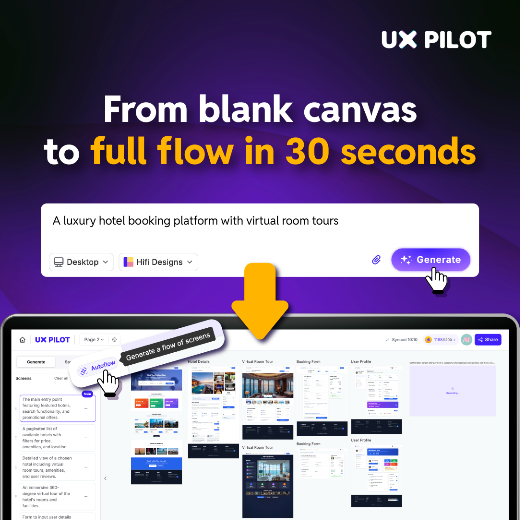Figma workflow. Linear glass. Buzz updates.
Sponsor
Turn text into UI/UX designs instantly
Tired of staring at a blank Figma file? With UX Pilot, just type what you need and get wireframes, hi-fi screens, and full flows in seconds. Import your design system, spark instant variants, and keep your designs on-brand without the grunt work.
Stop wasting hours on layouts. Start exploring more ideas, faster.
What’s New
Schema by Figma
A reminder that Figma’s free virtual conference for the design systems community is happening this week on Tuesday, October 28, from 9:00 am to 2:00 pm PDT. Besides the keynote, I’m especially interested in talks “Spectacular slots” by Nathan Curtis and “Crafting design context for agentic coding workflows” by Jake Albaugh.
Lessons learned in AI and design workflows
Sara Clayton from Dropbox shares some of her recent lessons and observations about experimenting with AI: “the design-to-engineering bridge is improving but not yet seamless, weak systems and shortcuts will be surfaced rather than hidden, true progress depends on internal champions who can push the boundaries, and – above all – critical thinking remains the foundation of good design.”
A Linear spin on Liquid Glass
I shared some of my thoughts on Liquid Glass in issue #229, so it was refreshing to see how Linear approached the new design language. Couldn’t agree with this more: “The one effect we chose not to reproduce was Liquid Glass’s refraction. Technically, it requires access to pixel-level data that isn’t available to third-party developers. Aesthetically, it also wasn’t the right choice because refraction can make dense professional interfaces harder to read. By relying on precise blurs, masking, and lighting, we maintained a sense of depth without losing clarity.”
Figma Make
Vibe Code in Figma Make with Miggi from Figma
Miggi joins Build, Launch & Earn to explore what’s possible when designers start thinking (and building) beyond the mockup. They talk about workflows, play with tools in real-time, and look at how this shift opens new doors — for freelancing, launching products, and building more value into your client work.
Figma Design
Figma Workflow
Christine Vallaure walks readers through her Figma workflow — how she combines everything, thinks through a project, and turns all those features into a working and maintainable file.
Code with Context using Figma MCP Server
Developer Advocate Akbar Mirza joins VS Code Live to discuss how the remote Figma MCP server and new Code Connect updates bring design and codebase context into VS Code, so you can generate production-ready code that is aligned with your design system.
Switch accounts easily on the mobile app
“With new multi-account support on mobile, quickly move between accounts without logging out or losing progress. Stay signed in, get notifications from all your accounts, access deep links with ease, and collaborate seamlessly on-the-go.”
Figma Buzz
Three new features to help build brand momentum with Figma Buzz
Three new features that deepen customization and control in Figma Buzz: configurable marketing templates using component properties, video trimming directly in Buzz, and easy access to plugins that help with digital asset management, translation, animation, and more.
Set up configurable templates in Figma Buzz
Designer Advocate Kaitie Chambers shows how to configure templates in Figma Buzz using component properties for faster, more flexible workflows — all while keeping your content intact and on-brand.
How to use plugins in Figma Buzz
In a quick demo, Product Designer Natasha Tenggoro shows how to use plugins in Buzz to insert brand-approved images, localize assets, and add animations, brand logos, QR codes, and more.
Backstage
Visibility at scale: How Figma detects sensitive data exposure
Dave Martin, Security Engineer at Figma, shares his experience building Response Sampling, a system designed to detect potential sensitive data leaks in real time. “By providing ongoing visibility into the data leaving our services, Response Sampling gives our teams the opportunity to investigate and address issues quickly, reducing the risk of exposure and improving our confidence in how data is handled.”

